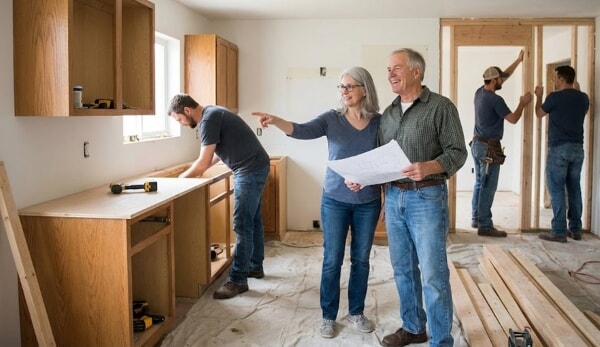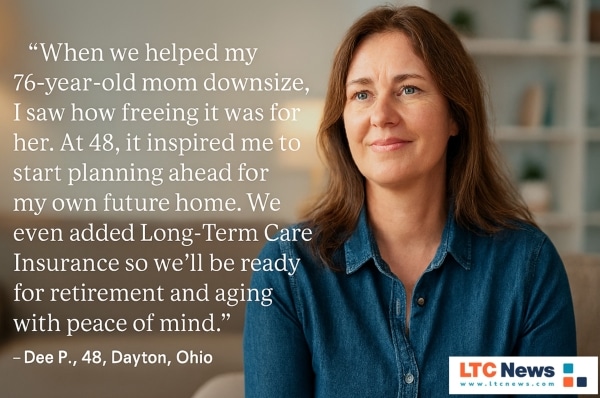Home Features That Make Aging in Place Easier and Safer

Table of Contents
You may not feel old, but you’ve likely started noticing small changes. Your knees complain when you climb stairs. You avoid icy steps in winter. You think more about safety, comfort, and how long you can stay in the home you love. Aging in place isn’t only about the future; it’s about making daily life easier now and avoiding major obstacles years from today.
The fact remains that you deserve a home that supports you as you age. Once you hit your 50s, you start thinking about how you will manage in your home as you get older. Your kids move out, and you start thinking about downsizing.
The home you buy today shapes your independence later. Many listings highlight granite counters or an updated deck, but they rarely mention the features that quietly determine whether a home will work for you long term. That leaves the responsibility on you to know what to look for.
Aging in place doesn’t mean “senior living.” It means living smarter. It means creating an environment that supports your mobility, your goals, and your dignity.
Single-Level Living
A single-level home reduces the risk of falls, eliminates the daily grind of going up and down, and makes navigating the house easier if mobility changes down the line.
Daily movement becomes harder with age, and stairs are one of the biggest culprits. A single-level home removes that barrier entirely. Everything stays on one floor — bedroom, kitchen, laundry, bathroom — so you move freely without extra strain.
Even outside of aging, you feel the difference:
- No hauling laundry baskets up and down steps
- No navigating stairs when recovering from a temporary injury
- No risk of falls after a long day or during midnight bathroom trips
A single-level floor plan supports you today and protects you tomorrow.
Entry Without Steps or Stairs
Aging in place starts at the front door. A flush entrance or gently sloped walkway eliminates the need to navigate stairs altogether. It also reduces fall risk in rain, snow, and ice.
A covered entry adds comfort and safety, especially when carrying groceries. You avoid juggling bags while balancing on narrow steps.
During home tours, many buyers overlook a single step into the foyer, but that lone step often becomes tomorrow’s renovation.
Updated Appliances with Safety Features
Older appliances may “still work,” but they often lack the safety and convenience that matter as you age.
Modern appliances offer:
- Automatic shut-off features
- Easy-to-read digital displays
- Quieter operation
- Energy savings that help with a fixed retirement income
If you’re moving into a place with newer systems, consider investing in a home warranty. This may be a good fit to cover major repair costs, especially if breakdowns stem from sloppy past installations or hidden wear and tear.
Walk-In Shower with Seating
Shower-tub combinations are one of the most common sources of falls in older adults. What you want is a walk-in shower with a low or no threshold and enough space to sit if needed, whether that’s a built-in bench or room for a secure shower seat. Why? Because nobody should be climbing over tub walls in their seventies. And beyond safety, it just makes bathing more pleasant. Comfort isn’t a luxury — it’s a plan.
You benefit from:
- Easier entry and exit
- Safer footing
- Reduced strain on hips and knees
- More comfortable bathing for decades
You shouldn’t be climbing over a tub wall in your seventies — and you don’t need to wait that long to enjoy a better, safer shower.
Wide Hallways and Doorways
Space to move is essential. A 28-inch doorway feels tight even when carrying laundry. As you age, narrow passages become a constant obstacle.
Ideal clearances:
- 32 inches or more for doorways
- 40 inches or more for hallways
These widths help you navigate comfortably to allow for movement that doesn’t feel cramped. You avoid shoulder bumps, awkward turns, and tight squeezes.
You also future-proof the home in case you ever use mobility aids. A house should move with you, not work against you.
Accessible Kitchen Layout
A kitchen can either support independence or slowly work against it. When evaluating a home, look for layouts that keep everything within reach. A kitchen that works for aging in place keeps key tools at reachable heights.
Key features include:
- Wall ovens mounted at a comfortable height
- Pull-out shelves and drawers
- Base cabinets that reduce bending and strain
- A microwave positioned below counter height
- Open floor space for safe movement while carrying items
An accessible kitchen isn’t about disability. It’s about designing a space that stays functional for decades.
Low-Maintenance Exterior and Yard
Ask yourself a simple question: Who will handle the upkeep? A home that looks beautiful today can become a burden later.
Low-maintenance design reduces the physical and financial demands of homeownership.
Look for:
- Vinyl or fiber cement siding
- Composite decking
- Simplified landscaping
- Minimal or no-yard setups
- Gutter guards or covered gutters
Repairs shouldn’t consume your free time. The right exterior lets you focus on living rather than maintaining. Pride in your home shouldn’t require a chore chart. A manageable exterior preserves your energy and helps you stay in the home longer.

Share your thoughts and experiences about aging, caregiving, health, retirement, and long-term care with LTC News —Contact LTC News.
Why These Features Matter for Long-Term Care Planning
Choosing the right home today helps you remain independent longer, thereby delaying or reducing the need for formal long-term care.
Even when you start needing help with daily activities, the right home lets you stay where you are. With a safe layout and the option to bring in home caregivers, you can remain independent without being pushed into assisted living before you’re ready.
The right home environment enables home care providers to better care for you. Nothing is more challenging than a home with multiple floors, stairs, and narrow doorways that force many people to move into assisted living.
Most long-term care begins at home, according to the U.S. Department of Health and Human Services (HHS). Your environment often determines how safely you can age and how much support you eventually need.
A safer home reduces:
- Fall risks
- Hospitalizations
- Caregiver strain
- Emergency relocations
Find Quality Caregivers
There are many options for in-home care, and if you have an age and disability friendly home, it gives you more options. If you or a loved one needs a caregiver, you can use the LTC News Caregiver Directory to search for caregivers and other long-term care providers with a quick and easy search by zip code.
You can explore potential future costs using the LTC News Cost of Extended Care Calculator, which provides current local pricing for home care, assisted living, and nursing homes:
Planning your home layout today can help preserve your independence, your savings, and your dignity tomorrow.
Experts say that too often, some people think aging in place means adding grab bars and ramps later. But the real secret is buying the right home from the start. The layout you choose at 55 will determine how well you can live at 75.
A Home That Works with You — Not Against You
The home you choose is part of your long-term care plan, whether you realize it or not. You aren’t just buying a layout; you’re buying mobility, comfort, and peace of mind.
Walk through potential homes with simple questions:
- Where would you trip?
- Where would you strain?
- Which spaces would become harder to navigate?
- Which features protect your future independence?
Aging in place should feel natural, not forced. With the right features, you stay independent longer, protect your savings, and ease the burden on loved ones.
Smart Choices Now
A safer home starts with the choices you make today. Begin evaluating your living environment through the lens of long-term independence. Explore downsizing to an aging-friendly home, review your future extended care costs, compare local resources, and consider whether Long-Term Care Insurance fits into your retirement plan.


